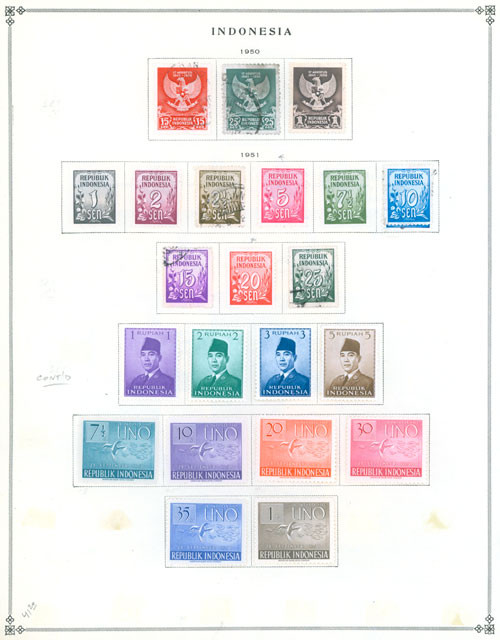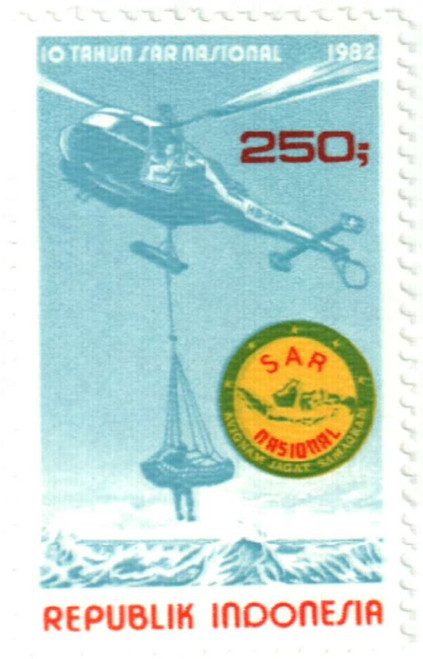
# MCC1240 - 1950-79 Indonesia
Issue Dates: 1950-1979
Scott Catalogue Value: $290.05
Mystic Price: $220.00
You Save: $70.05
Indonesia collection has approximately 500 stamps and 25 album pages. Many sets with slightly more mint than postally used issues. Collection begins with #333, the first stamp issued by the United States of Indonesia. Among the many nice mint sets are #362-67, the 1951 commemoratives honoring the United Nation’s sixth anniversary (value $30.75) and #550-73, the 1962 4th Asian Games issues.
Approximately one million years ago, volcanoes erupted in the South Seas and created over 13,000 islands that today are collectively known as Indonesia.
The Republic of Indonesia, the fifth most populated country in the world, is difficult to pinpoint on the world map. Its long chain of islands is spread out over 735,000 square miles and drapes itself over the equator between Asia and Australia.
Like so many countries around the world, Indonesia has had its share of conquerors. Early 7th-century Indian influence was in place in the 16th century when the Portuguese arrived. The Portuguese promptly lost control to the English and the Dutch, who juggled Indonesia between them for years, until the Japanese took over during World War II. Today, Indonesia is an independent republic where over 250 different languages are spoken.
The volcanoes that created Indonesia still erupt, and the mountains make traveling between the islands difficult, but visitors say some of the most beautiful and unexplored territory in the world can be found there. Indonesia also has lush tropical rain forests that are home to many exotic plants and animals. For instance, the Komodo dragon is actually a huge lizard, four meters in length.
The island of Java makes up only seven percent of Indonesia, but it is where most people live. Javanese are mainly farmers who grow crops like rice, corn, peanuts, coconuts, cassava, peanuts, sweet potatoes, spices and coffee. Visitors to Java find this the most “Indonesian” part of Indonesia, where great Hindu and Buddhist dynasties created immense temples and monuments to their gods.
Bali is a picture-perfect tropical island where many nights are festival nights. Religion is very important to the Balinese, and every village has at least three temples. Most festivals are held to celebrate “temple birthdays” every 210 days (the length of the Balinese year). These festivals often last for days, with processions and holy offerings in the temple during the day, and a country fair atmosphere in the streets at night.
Dance is a very important form of expression to the Balinese people. One such dance, the “monkey dance,” tells the story of a woman who is captured and rescued by a monkey army. Another, called the Legong, is a graceful dance performed by young girls in dazzling costumes, telling the tale of a little bird who warns the king of terrible trouble if he goes to war. The king ignores the bird and is killed.
Issue Dates: 1950-1979
Scott Catalogue Value: $290.05
Mystic Price: $220.00
You Save: $70.05
Indonesia collection has approximately 500 stamps and 25 album pages. Many sets with slightly more mint than postally used issues. Collection begins with #333, the first stamp issued by the United States of Indonesia. Among the many nice mint sets are #362-67, the 1951 commemoratives honoring the United Nation’s sixth anniversary (value $30.75) and #550-73, the 1962 4th Asian Games issues.
Approximately one million years ago, volcanoes erupted in the South Seas and created over 13,000 islands that today are collectively known as Indonesia.
The Republic of Indonesia, the fifth most populated country in the world, is difficult to pinpoint on the world map. Its long chain of islands is spread out over 735,000 square miles and drapes itself over the equator between Asia and Australia.
Like so many countries around the world, Indonesia has had its share of conquerors. Early 7th-century Indian influence was in place in the 16th century when the Portuguese arrived. The Portuguese promptly lost control to the English and the Dutch, who juggled Indonesia between them for years, until the Japanese took over during World War II. Today, Indonesia is an independent republic where over 250 different languages are spoken.
The volcanoes that created Indonesia still erupt, and the mountains make traveling between the islands difficult, but visitors say some of the most beautiful and unexplored territory in the world can be found there. Indonesia also has lush tropical rain forests that are home to many exotic plants and animals. For instance, the Komodo dragon is actually a huge lizard, four meters in length.
The island of Java makes up only seven percent of Indonesia, but it is where most people live. Javanese are mainly farmers who grow crops like rice, corn, peanuts, coconuts, cassava, peanuts, sweet potatoes, spices and coffee. Visitors to Java find this the most “Indonesian” part of Indonesia, where great Hindu and Buddhist dynasties created immense temples and monuments to their gods.
Bali is a picture-perfect tropical island where many nights are festival nights. Religion is very important to the Balinese, and every village has at least three temples. Most festivals are held to celebrate “temple birthdays” every 210 days (the length of the Balinese year). These festivals often last for days, with processions and holy offerings in the temple during the day, and a country fair atmosphere in the streets at night.
Dance is a very important form of expression to the Balinese people. One such dance, the “monkey dance,” tells the story of a woman who is captured and rescued by a monkey army. Another, called the Legong, is a graceful dance performed by young girls in dazzling costumes, telling the tale of a little bird who warns the king of terrible trouble if he goes to war. The king ignores the bird and is killed.






